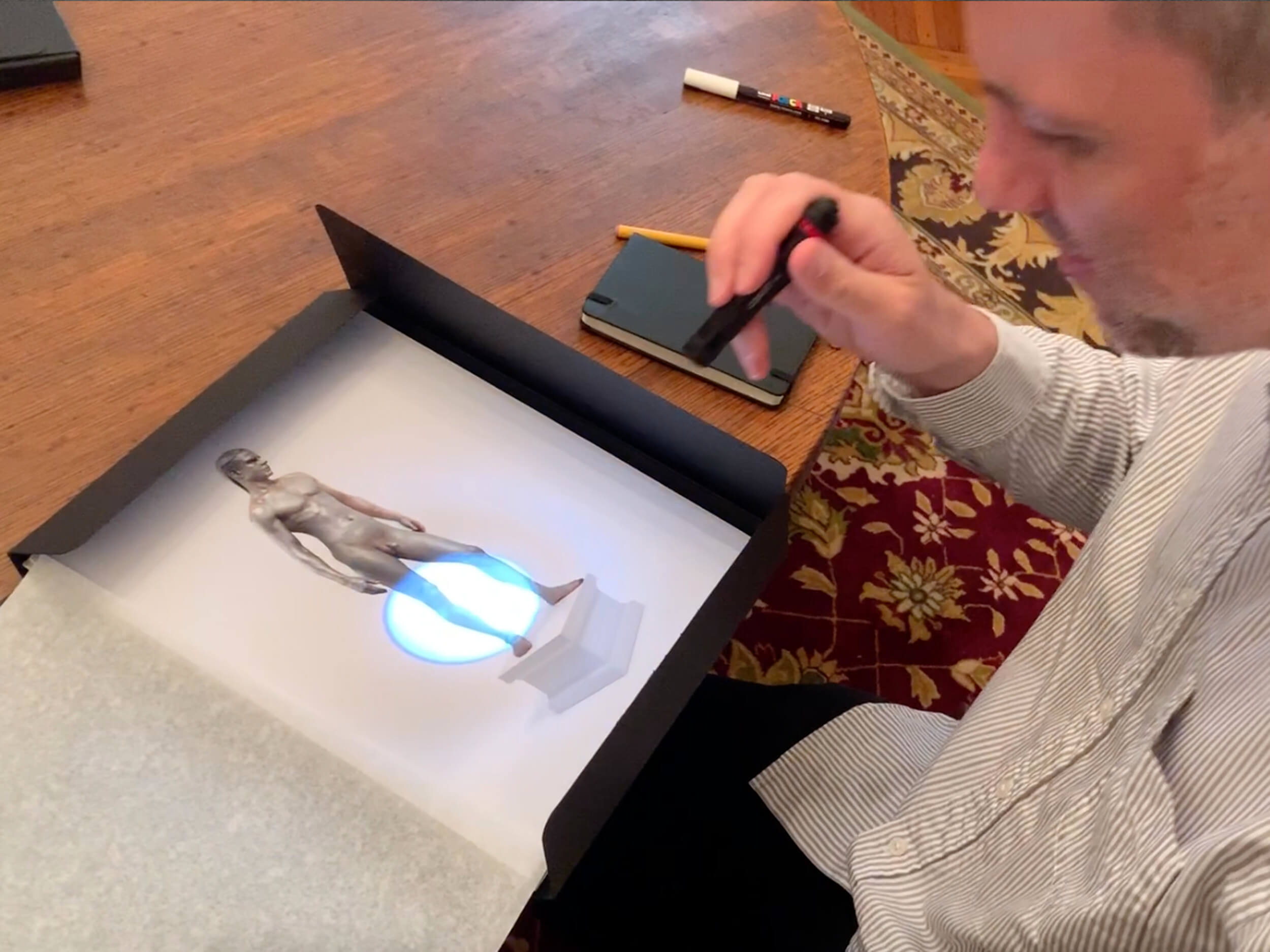2019
12 copies
Signed and numbered
12 copies
Signed and numbered
31×25×10 cm
12.2×9.8×3.9 in.
12.2×9.8×3.9 in.
4×8 numbered archival prints
1 folder with a pair of anaglyph glasses
1 folder with a pair of anaglyph glasses













Reproducing a work of art in book form is an inevitable failure. Even with the most up-to-date printing techniques, a reproduction inevitably returns a poor version of the original regardless of how the image is created, lit, photographed, sometimes scanned, often photoshopped, and finally printed.
For his first project with Three Star Books, Frank Benson has approached this problem by creating a portfolio of images that document his celebrated series of Human Statue sculptures in the form of 3D renderings, exported directly from the software he used to create the work. Over the course of the series, which began in 2005, Benson has made increasing use of 3D modeling and rapid prototyping technology. Inevitably, adjustments and compromises are required as each sculpture makes the journey from 3D virtual model to physical object. Rather than documenting the final object, the images in “CATALOG 1” capture the sculptures in their ideal states, before they entered the real world.
“CATALOG 1” includes a selection of eight views – seven photographic renderings and one anaglyph rendering per sculpture . The anaglyph image can be viewed using the once revolutionary cyan and magenta 3D glasses invented by W. Rollman in 1835.
“CATALOG 1” by Frank Benson is a combination of a sculpture and a book. If the sculptures seem to float in front of us, there is no illusion: the works face us as we face them. Our confrontation with the artist’s subjects in “CATALOG 1” is as crucial and imperative as it is in the world; Benson has once again destabilized the viewer.
“CATALOG 1” provides us with the certainty that it is impossible to be sure of what we see and experience.
Frank Benson (b. 1976) studied at Maryland College of Art, Baltimore, 1998, and for a Master of Fine Arts at the University of California (CA), 2003. The artist lives and works in Brooklyn, NY. Benson’s three-dimensional and photographic works both reflect a sustained fascination with concepts of arrested movement and the use of digital tools in the creation of sculpture. Increasingly, he has employed high-tech software in the production of works – for example translating photographs of human models into meticulously-crafted ‘wireframe’ virtual models and 3-D prints, that serve as the basis for hyper-real and minutely-finished statues, as seen in his celebrated sequence of “Human Statue Series”.
For his first project with Three Star Books, Frank Benson has approached this problem by creating a portfolio of images that document his celebrated series of Human Statue sculptures in the form of 3D renderings, exported directly from the software he used to create the work. Over the course of the series, which began in 2005, Benson has made increasing use of 3D modeling and rapid prototyping technology. Inevitably, adjustments and compromises are required as each sculpture makes the journey from 3D virtual model to physical object. Rather than documenting the final object, the images in “CATALOG 1” capture the sculptures in their ideal states, before they entered the real world.
“CATALOG 1” includes a selection of eight views – seven photographic renderings and one anaglyph rendering per sculpture . The anaglyph image can be viewed using the once revolutionary cyan and magenta 3D glasses invented by W. Rollman in 1835.
“CATALOG 1” by Frank Benson is a combination of a sculpture and a book. If the sculptures seem to float in front of us, there is no illusion: the works face us as we face them. Our confrontation with the artist’s subjects in “CATALOG 1” is as crucial and imperative as it is in the world; Benson has once again destabilized the viewer.
“CATALOG 1” provides us with the certainty that it is impossible to be sure of what we see and experience.
Frank Benson (b. 1976) studied at Maryland College of Art, Baltimore, 1998, and for a Master of Fine Arts at the University of California (CA), 2003. The artist lives and works in Brooklyn, NY. Benson’s three-dimensional and photographic works both reflect a sustained fascination with concepts of arrested movement and the use of digital tools in the creation of sculpture. Increasingly, he has employed high-tech software in the production of works – for example translating photographs of human models into meticulously-crafted ‘wireframe’ virtual models and 3-D prints, that serve as the basis for hyper-real and minutely-finished statues, as seen in his celebrated sequence of “Human Statue Series”.

